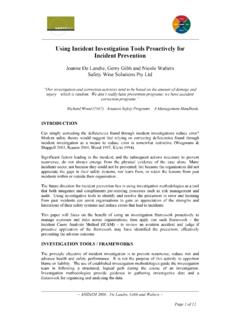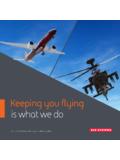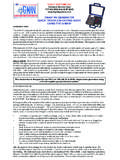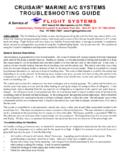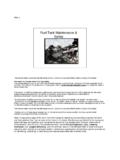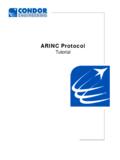Transcription of The Evolution of Flight Data Analysis - ASASI …
1 The Evolution of Flight data Analysis Neil A. H. Campbell MO3806. Neil graduated in 1983, with a Bachelor of Engineering degree (Electronics), from the University of Western Australia. In 1986 he joined the Bureau of Air Safety Investigation as a Flight recorder specialist. Neil took a leave of absence during 1994- 1995 and managed the Flight data Analysis program for Gulf Air in Bahrain. During 1998 he was a member of the ICAO Flight Recorder Panel that developed changes to ICAO Annex 6. In February 2000, Neil joined the Corporate Safety Department of Cathay Pacific Airways Limited in Hong Kong. During 2001 and 2002 he held the position of Manager Air Safety. In December 2003 he rejoined the Australian Transport Safety Bureau as a Senior Transport Safety Investigator. CONTENTS. 1. Introduction 2. History of Flight recording 3. data collection Flight data recorders Boeing 707.
2 Airbus A330. Embraer 170. Airbus A380. Boeing 787. Onboard avionics ATC datalink message recording ADS-B data 4. data recovery Wireless transmission of QAR data FDR data recovery FDR system documentation 5. Readout equipment 6. Analysis data listings and plots Airline Flight data Analysis programs Animations Simulations Comparison techniques Geographical Information System (GIS) Tools 7. Conclusion 1. 1. INTRODUCTION. Although the usefulness of Flight data recorders (FDR's) and cockpit voice recorders (CVR's). for accident investigation purposes is now well accepted, this has not always been the case. Consider this report from 19621 referring to the introduction of CVR's to the UK there is pretty general agreement in the UK that speech is of little, if any, real use, and furthermore that anything above 15 minutes recording is a waste. The requirement, if it comes, is expected to be 5 minutes.
3 This paper describes the Evolution of Flight data Analysis for commercial aircraft and considers the entire process from data collection, data recovery, readout equipment and Analysis tools. 2. HISTORY OF Flight RECORDING. During World War II the NACA2 V-g recorder3 was introduced in transport, bomber and fighter aircraft to assess the operational loads met infrequently and structural design requirements for aircraft. This instrument records the peak accelerations and the speed at which these occur in Flight . By 1950 the data from these instruments had become inadequate due to the importance of fatigue damage and the need for aircraft height to assess the structural and aerodynamic implications of gust or manoeuvre loads. Thus V-g-h continuous trace recorders in the USA and counting accelerometers in the UK were introduced in the early 1950' . In Australia, Dr David Warren was certain of the importance of recorded data for accident investigation purposes and he and his team at ARL5 pioneered the development of a combined voice and data During the 1960's, regulatory authorities around the world began to require FDR's and CVR's to be fitted to large commercial aircraft.
4 Today the FDR and CVR are an accepted part of aviation with the debate now about the need for image recorders and extending recorder carriage requirements to smaller aircraft. Figure 1: Developments in solid-state FDR's show a decrease in size and weight7. 1. Aircraft Australasia's Aviation Magazine, July 1962, page 28. 2. NACA: National Advisory Committee for Aeronautics. 3. V-g recorder: a non-crash protected device that recorded indicated airspeed (V) and load factor (g). 4. Sturgeon (1969), Technical Prospects of the Use of Digital Flight Recorders for Operational Research and Accident Prevention, RAE Technical Report 69201. 5. ARL: Aeronautical Research Laboratory. 6. 7. Photograph from M. H. Thompson, A Vision of Future Crash Survivable Recording Systems, Honeywell. 2. 3. data COLLECTION. Flight data recorders Both crash-protected Flight data recorders (FDR's) and optional quick access recorders (QAR's).
5 Began to be installed on commercial aircraft in the 1960's. The Evolution of these data collection devices is shown by using the following aircraft types as examples: Aircraft Type Introduced FDR Type Number of FDR data into service parameters capacity Boeing 707 1958 Analogue 5 Mechanical limit of about 10. parameters Airbus 330 1993 Digital 280 128 wps8 (serial (solid-state or data input). tape medium). Embraer 170 2004 Digital 774 256 wps (serial (solid-state) data input). combi-recorder Airbus 380 2007 Digital > 1,000 1,024 wps (serial (solid-state) data input). Boeing 787 2009 Digital > 1,000 Ethernet system (solid-state). EAFR9. 8. wps: words per second. An FDR word consists of 12 bits. 9. EAFR: Enhanced Airborne Flight Recorder. A combi-recorder that stores both cockpit audio and Flight data . The EAFR also has the capability of storing video information.
6 3. Boeing 707. The Boeing 707 (B707) was typically equipped with a five parameter10 analogue FDR. data was recorded by engraving traces onto a metal foil. Within the recorder were pitot/static and electrical sensors separate to the aircraft sensors used by the crew. Calibration of the FDR. sensors and general reliability of a mechanical recorder were problems for investigators relying on this data . Figure 2: Access to FDR via access panel in rear fuselage Figure 3: The canister in the tail containing the FDR. 10. Pressure altitude, indicated airspeed, magnetic heading, vertical acceleration (load factor) and microphone (radio) keying versus time. 4. Figure 4: The FDR inside the canister Figure 5: Lockheed Aircraft Service model LAS-109C FDR. The canister improved the reliability of the FDR by protecting it from the pressure, temperature and humidity variations experienced inside the unpressurised tail of the B707.
7 An alternative FDR for the B707 was the Lockheed Aircraft Service model LAS-109C FDR. It was a spherical analogue recorder and was coloured yellow - it weighed kg. The pneumatic and electrical connections to the FDR are visible in Figure 5. Figure 6: Davall Wire FDR. Some later model B707's were equipped with an early type of digital FDR. This recorder was coloured flame orange and was known as a red egg . A digital multiplexing technique was used and the data was magnetically recorded onto a thin wire. This technique was based on the black box prototype developed by the Australian scientist Dr David Warren. 5. Airbus A330. The A330 is equipped with a solid-state FDR and a separate solid-state CVR. The FDR. receives data from an interface unit11 so the FDR system is a two-box system. Additionally some airlines choose to fit a QAR12 that receives data from the same interface unit as the FDR.
8 And records the same parameters as the FDR. Figure 713 shows a QAR and FDR connected to the same acquisition unit. This configuration requires three boxes. A QAR can also receive data from a separate data Management Unit (DMU). When a DMU is used, Airbus label the recorder a DAR14 rather than a QAR. With a DMU, the airline can program the parameters that the DAR will record so it is more flexible than a QAR which records exactly the same parameters as the FDR. Four separate avionics boxes are required for an aircraft equipped with an FDR and a DAR. Figure 7: 11. Flight data Interface Unit (FDIU) in Airbus terminology or Flight data Acquisition Unit (FDAU) in Boeing terminology. 12. QAR: Quick Access Recorder. An optional non-crash protected recorder that airlines can install to provide access to Flight data . It is more accessible and can record for a longer duration than the FDR.
9 13. Flight data Recording & Airplane Condition Monitoring, Boeing Airliner magazine, April-June 1992, page 4. 14. DAR: Digital ACMS Recorder. 6. Embraer 170. Embraer 170 aircraft are equipped with two digital voice data recorders (DVDR's). A DVDR is a combi-recorder that records both cockpit audio and Flight data in a single box. To improve the probability of both audio and Flight data surviving an accident, one DVDR is located in the front of the aircraft and one in the rear of the aircraft as shown in Figure 8. There is an advantage to the operator in having only a single part number in their inventory and presumably some MEL relief would apply as well. Figure 8: DVDR location in the Embraer 17015. Airbus A380. The A380 will have a networked avionics architecture but will retain the standard configuration of a solid-state FDR and a separate solid-state CVR.
10 Rather than a separate QAR, A380. operators will be able to use the two servers that will be installed onboard running the Linux operating system. Information stored on the servers will include Flight data , Flight operations quality assurance data , electronic Flight bag documents and other software. The two Airbus servers will receive data through a secure communications interface from the A380's Avionics Full Duplex (AFDX) switched ethernet avionics network16. A380 operators will be able to choose to add a third server attached to the network through a secure router. The operator can then host its own applications and modify them at will as long as configuration control is maintained. Applications such as weight and balance, trouble- shooting guides and wiring diagrams could be hosted. 15. From the Embraer 170/175 Aircraft Maintenance Manual. 16.

